
|
Sale 46
The Millennia Collection
| Lot |
Photo |
Description |
Realized |
Lot 714 |
 |
Italian States -- Cisalpine Republic. Silver Scudo of 6 Lire, Anno VIII (1800). Dav-199; Cr-2. Seated and standing figures representing France and the Cisalpine. Reverse: Value and date within wreath. Beautiful deep, multi-hued blue and gold iridescent toning, combined with a magnificent strike. Splendid eye appeal. A charming, rare and historic coin. NGC graded MS-67.
The Cisalpine Republic was established by Napoleon to control northern Italy. Although technically independent, it was effectively little more than a client state of France. Its goal was to unite all Italian speaking regions into one nation. This totally alienated Switzerland with its Italian speaking south. Fortunately for Switzerland, the Cisalpine Republic only lasted until 1802. Here is one of the finest known examples of this exotic, short-lived issue.
Estimated Value $3,000 - 4,000.
Ex Irving Goodman Collection; Illustrated in Money of The World, coin 122.
View details and enlarged photos
| Realized
$10,925 |
Lot 715 |
 |
Italian States - Genoa. Genovino, ND. Fr-354. 3.54 grams. Simone Boccanegra, 1339-1344 and 1356-1363. Obv. Castle within an ornate border. Reverse Cross pattee within floral decorations around cross all within octafoil. Leg: +CONRADUS: REX: ROMANORUN. Lightly cleaned. Extremely Fine.
Estimated Value $800 - 1,000.
(*).
View details and enlarged photos
| Realized
$1,898 |
Lot 716 |
 |
Genova. Ducat, ND. Fr-375; CNI-III,Pl.VI,7. 3.43 grams. 20.42 mm. Ludovico DI Campofregoso Doge XXVII, 1447-1450 and 1461-1462. Obv. Castle within floral decorations. Leg: +:L: C: DVX: IANVEN: XXVII.: Reverse Cross pattee within floral decorations. Leg: + : CONRADVX: REX: ROMANOR: A (A in D): Very Rare. NGC graded AU-55.
This ducat is one of the great rarities of this sale. The doges were theoretically chosen from the general populace, but were effectively chosen from a few wealthy families. In fact, two families, the Adornos, and Fregosos dominated the elections.
Estimated Value $10,000 - 12,500.
(*).
View details and enlarged photos
| Realized
$16,100 |
Lot 717 |
 |
Genova. Ducat, ND. Fr-379; CNI III, Pl.VI,9. 3.37 grams. 20.43 mm. Paolo DI Campofregoso, 1463-1464. Obv. Castle flanked by P C. Leg: :P :C :DVX: IANVEN: XXIII. Reverse Cross in octafoil. Leg: +: CONRADVX. REX. ROMANOR: B. Very Rare. NGC graded AU-58.
Estimated Value $15,000 - 20,000.
(*).
View details and enlarged photos
| Unsold |
Lot 718 |
 |
Genova. Ducat, ND. Fr-381; CNI-III, Pl.VI,6. 3.45 grams. 20.73 mm. Francesco I Sforza Duca DI Milano, Signore DI Genova, 1464-1466. Obv. Castle gate within beaded inner circle. Leg: F: S: DVX: MEDIOLANI: D: IAN Reverse Cross within octofoil. Leg: + :CONRADVX: REX: ROMANO: T: NGC graded AU-55.
Francesco Sforza, Duke of Milan, occupied Genoa at the end of his long and tumultuous reign. His rule was shortlived, so his coins are very scarce.
Estimated Value $5,000 - 6,000.
(*).
View details and enlarged photos
| Unsold |
Lot 719 |
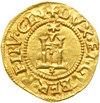 |
Genova. Scudi d'oro, ND. Fr-412; CNI III, 206. 3.36 grams. 23.09 mm. The Biennial Dogees, 1528-1797. CG, magistrate (1528-1541). Obv. Castle. Leg: + DVX. ET.GVBER.REIPV.GEN. Reverse Cross pattee. Leg: + CONRADVS. REX.ROMA.CG. NGC graded MS-62.
Starting in 1528, Andrea Doria enacted the reform allowing the doges to rule for only two years. From then on, the rulership in Genoa was known as the biennial doges. The coins are mostly distinguished by the magistrate's initials.
Estimated Value $1,200 - 1,500.
(*).
View details and enlarged photos
| Realized
$2,013 |
Lot 720 |
 |
Genova. ½ Doppia, 1563. Fr-420;CNI III, p.263.2. 3.21 grams. 21.10 mm. The Biennial Doges, 1528-1797. AS-Magistrate. Obv. Castle within beaded inner circle, date under castle. Leg: +DVX* ET* GVB* REIP* GENV Reverse Cross pattee. Leg: + CONRADVS* II* RO* REX*AS. NGC graded MS-61.
The 1/2 Doppias are quite rare and seldom offered. This is an exceptional example of the type.
Estimated Value $3,000 - 3,500.
(*).
View details and enlarged photos
| Unsold |
Lot 721 |
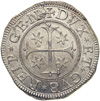 |
Italian States -- Genova. Scudo Stretto, 1679. Dav-3901. Cross with stars in angles. Reverse: Virgin Mary and child on cloud, stars above. Deeply lustrous and superbly struck on a broad, oblong flan, with original silvery surfaces. As fine as piece as we can remember. NGC graded MS-64.
Genoa owed its power to Andrea Doria, who unofficially ruled the port city, as Admiral-in-Chief for the Spanish Habsburgs, from 1528 to 1550. Through his wisdom, and by arranging for the Genoese bankers to handle the Habsburg fortune, he helped Genoa attain great wealth. Its strategic placement on the Ligurian Sea, backed by a coinage of high value, as well as its Catholic fealty, were reflected for centuries through its silvery scudos, represented in this monumental collection by this fabulous specimen.
Estimated Value $4,000 - 5,000.
Ex Irving Goodman Collection.
View details and enlarged photos
| Realized
$8,338 |
Lot 722 |
 |
Italian States -- Genoa. Silver Scudo Largo, 1693. Dav- & Sond-555; CNI-8; Gnecchi Coll. --. 38.29 grams. The Biennial Doges, 1528-1797. Nimbate Madonna and Child receiving crown of stars from flanking cherubs. Reverse: Floriated cross before saltire cross, winged angel-heads in the quarters. Slight doubling to obverse, nevertheless an exceptional strike on a fabulous full flan, with lovely, artistic silver gray toning. One of the more handsome Italian coin designs. Extremely rare, as a type, and this one is splendid, a classic of its age. (Too large for holder). NGC graded AU-55.
Estimated Value $5,000 - 6,000.
Illustrated in Money of The World, coin 112.
View details and enlarged photos
| Realized
$7,763 |
Lot 723 |
 |
Italian States -- Genoa. 8 Lire, 1796. Dav-1370; CNI-III, p. 499, 8; C-16a. 33.39 grams. The Biennial Doges, 1528-1797. Crowned shield of arms, supported by flanking griffins, standing on pediment with lion mask below. Reverse: Nimbate St John the Baptist stands frontal, head left, in animal-skin tunic and draped by cloak, holding small bannered cross. Exceptional strike, with centers only just a bit soft, faint adjustment marks visible in the shield, appealing muted luster, very clean, lovely old toning consisting of softly iridescent pinks and coppers, or blues, in the recesses. A quality example -- very rare in this grade. NGC graded MS-62.
Estimated Value $2,500 - 3,000.
Ex Kunker Auk. 95 (9-29-04), lot 3871.
View details and enlarged photos
| Realized
$2,875 |
Lot 724 |
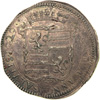 |
Italian States -- Mantua. Scudo of 160 Soldi, 1629. Brause-Mansfield 28, 3; Gnecchi-2200; Dav-3958; KM-231. 29.79 grams. Charles I of Nevers, Duke of Mantua, 1627-1637. Crowned and garnished quartered shield of arms. Reverse: Sunflower tilts to radiant sunface, all within wreath; "160" below. Some slight double-striking, with occasional flatness in the legends, nevertheless bold for issue. Appealing old toning, tending to the pinks and violets, over considerable remaining luster. Very rare, especially in this grade. NGC graded AU-55.
Mantua's history is most ancient, the area being settled at least 4,300 years ago. In the 6th century BC it ranked among the more important Etruscan cities. Rome conquered it in the 3rd century BC, and incorporated it into its territories then known as Cisalpine Gaul. Under the Romans it would be most remembered as the birthplace of their most revered poet, Virgil.
Strategically located on the Lombard plain near the Alpine passes, after the fall of Rome it passed in succession through the hands of the Goths, Byzantines, Langobards and Franks, finally becoming a possession of Canossa. In the Middle Ages and Renaissance, Mantua rose to political and cultural prominence under the rule of the Bonacolsi and Gonzaga families. For three centuries, from 1328-1628, Mantua was one of the major European courts of artistic, cultural, religious and military importance. A century later, Mantua passed back and forth between the hands of the French, the Austrians, other Italians, Napoleon, and the Austrians again, until it finally became incorporated into a united Italy.
Its coinage during the period represented by this exceptional specimen is very rare, as later meltings consumed most known examples. Although simple in design, which reflects the city symbolically, its position in this collection is of considerable importance.
Estimated Value $9,000 - 10,000.
View details and enlarged photos
| Realized
$10,925 |
Lot 725 |
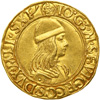 |
Italian States -- Milan. Doppio Ducato, ND (1481). Fr-693 var.; Crippa-1; cf. Gnecchi Coll. no. 2808. 6.97 grams. Giovanni Galeazzo Maria Sforza, 1476-1494. Youthful armored bust right, wearing cap; IO'G3'M'SF'VICE - COS'DVX'MILI'SXT'. Reverse: Elaborately plumed helmets over quartered shield of arms; PP'ANGLE - Q3'COS'7C'. Boldy struck up on a full or broad flan, and softly lustrous, with slight reddish toning. Extremely rare. Truly elegant numismatic art of the early Renaissance. NGC graded MS-64.
The Sforzas of Milan were as ambitious and corrupt as any princely family could be. Giovanni ascended to the throne at age seven, after the assassination of his father. His uncle, Ludovico Sforza, ruled as regent, and took all the power away from young Giovanni (also know as Gian). When he died in 1494, it was believed by many that Uncle Ludovico poisoned him.
Estimated Value $15,000 - 20,000.
Illustrated in Money of The World, p. 151, coin plate #94.
View details and enlarged photos
| Realized
$34,500 |
Lot 726 |
 |
Italian States -- Milan. Gold Doppia, 1578. Gnecchi-123, 10; Crippa-4/A; Fr. 716. 6.60 grams. Philip II, of Spain, 1554-1598. Radiate, cuirassed and draped bust right, 1578 in exergue. Reverse: Quartered shield of arms, crowned and plumed. Faint doubling on obverse (trivial compared to that on most known examples), otherwise an exceptional strike for issue. Lustrous with beautiful color. Rare in this excellent state of preservation. NGC graded MS-64.
Philip came to the Spanish throne upon the abdication of his father, the Holy Roman Emperor Charles V, in 1556. He was ruler of Naples and Sicily, Franche-Comte, the Low Countries and the Duchy of Milan. During his reign, vast riches continued to pour in unabated from the New World but hostilities with England and the diversion of money by bankers in Antwerp, Augsburg and Milan, who were funding Spain's wars, and then by bankers in Genoa and Milan, stimulated those economies but finally bankrupted Spain in 1596, and after Philip's death Spain entered a long period of decadence, moving from center stage on the world's theater to a back row. This marvelous coin of the Renaissance issues from perhaps its most glorious moment in history.
Estimated Value $3,000 - 3,500.
Illustrated in Money of The World, coin 83.
View details and enlarged photos
| Realized
$3,795 |
Lot 727 |
 |
Italian States -- Milan, Filippo, 1707. Dav-1380. 27.75 grams. Archduke Charles, as Charles III, Pretender to the Throne of Spain, 1707-1711. Draped and cuirassed bust right, with elaborately curled hair. Reverse: Crowned Bourbon arms of Spain. A very fine example of this frequently crude issue. Handsome old toning, lightly iridescent on reverse. NGC graded AU-58.
Archduke Charles played a major role in the War of the Spanish Succession, a war that lasted ten years, killed over 400,000 people and accomplished little. After Charles II of Spain died in 1700, there was a conflict to the succession between the Habsburg Charles III and the French Angevin Philip V. Finally, a compromise was reached: Charles got the Holy Roman Empire, and Philip got Spain but had to renounce all claims to the French throne.
Estimated Value $3,000 - 4,000.
View details and enlarged photos
| Realized
$3,450 |
Lot 728 |
 |
Italian States -- Milan. 6 Lire, 1778. Dav-1386; C-36. 23.11 grams. Maria Theresa, 1740-1780. Mature crowned, draped and veiled bust right. Reverse: Crowned, quartered oval shield, supported by sprays. Excellent strike, with only slight adjustment marks visible in shield. Clean and retaining much of the cartwheel effect in its luster beneath even old toning, with hints of iridescent russets and greens. Attractive mature portrait. Rare in this grade. NGC graded MS-62.
Milan, in northern Italy, was ceded to the Holy Roman Empire in 1713, a state of occupation that lasted until Napoleonic times. The Empress Maria Theresa, most unpopular in Milan, is pictured here. Many of her coins were defaced by Milan's citizenry.
Estimated Value $2,500 - 3,000.
View details and enlarged photos
| Realized
$2,588 |
Lot 729 |
 |
Italian States -- Modena. Tallero of 3 Scudi, 1782. Dav-1393; CNI-IX, no 368. 27.72 grams. Ercole III, d'Este, 1780-1796. Bust left, wearing Order of the Golden Fleece. Reverse: Large crowned arms supported on eagle below, wreathed by two elaborate chains of Royal Orders. Greatly detailed by a sharp strike, with only trifling flatness at the Orders beneath shield. The reverse fields show bold cartwheel luster. Nicely toned, the lighter reverse with multi-colored iridescence, tending to blue and green. Rare in this quality. NGC graded MS-61.
Periodically various Italian states would issue the tallero, a coin aligned in size and weight to serve as a counterpart to the German and Habsburg thalers. This Modena issue must have have been intended for central European consumption, since the famed Maria Theresa talers, and the Dutch lion dollars, were already successful Far Eastern trade coins. The image here is easily compared, in the style of its engraving and in the dress of the ruler, with early American images of George Washington and other statesmen.
Estimated Value $5,000 - 6,000.
View details and enlarged photos
| Realized
$6,038 |
Lot 730 |
 |
Naples. Ducat, ND. Fr-827; CNI-XIX,Pl. XII,2. Ferdinando and Isabela, 1504. Isabella died 1504. Obv. Crowned busts facing each other, within beaded border. Leg:+ QVOS DEVS CONIVNGIT.OMO.NON SEP Reverse Crowned arms flanked by I-T. Leg: FERNANDVS.ET.ELISAB.D:G One year type, Very Rare. NGC graded MS-61.
The French rule of Naples lasted just a few years. Ferdinand and Isabella, in alliance with Emperor Maximilian I, retook Naples. He appears here with Isabella. She died later in the same year, so almost no coins of Naples with both their portraits were struck. A great rarity.
Estimated Value $20,000 - 25,000.
(*).
View details and enlarged photos
| Unsold |
Lot 731 |
 |
Italy -- Kingdom of Naples. Silver 120 Grana, 1808. Dav-165; Mont.-408; KM-100. 27.44 grams. Joseph Napoleon, 1806-1808. Bare head left. Reverse: Crowned arms, escutcheon at center, flanked by mermaid supporters. Detailed, even, exceptional strike. The devices matte to softly lustrous, on reflective fields. Golden to medium gray toning. Exceptional quality, with appealing portrait. Very rare in this grade. NGC graded AU-58.
Joseph was Napoleon's older brother. He took over the rule of the kingdom of Naples, but soon was given the larger and more prestigious kingdom of Spain. An excellent administrator, but a general of questionable ability, he ultimately spent seventeen years exiled in the United States! The portrait of him on this specimen is among the finest known.
Estimated Value $4,000 - 5,000.
Illustrated in Money of The World, coin 126.
View details and enlarged photos
| Realized
$4,600 |
Lot 732 |
 |
Italy -- Papal States. Piastra, Year III (1693). Dav-4103; KM-569; CNI-36; Muntoni-23; Serafini-34; Berman-2229. 32.06 grams. Innocent XII (Antonio Pignatelli), 1691-1700. Draped and capped bust right. Reverse: Charity seated right, with infant at breast, two toddlers at feet; date incuse on column, arms of Mnsr. Farzetti below. Splendid strike and centering. Handsome, old artistic toning. Rare, particularly in this quality. NGC graded MS-61.
One of the better Popes, Innocent had to wait five months to be elected after the death of the previous pope. He was the compromise candidate between the French and Imperial factions, and eventually worked to eliminate nepotism and simony, two of the major abuses of the church. Had Innocent served two hundred years earlier, perhaps Martin Luther would not have had so much to complain about and there would have been no split from the Catholic Church. His Eminence is splendidly represented on this beautiful coin.
Estimated Value $3,000 - 3,500.
Illustrated in Money of The World, coin 114.
View details and enlarged photos
| Realized
$4,255 |
Lot 733 |
 |
Italy -- Papal States. Scudo, 1829-R (Rome). Dav-188; KM-1303; CNI-XVII, 257, 2; Berman-3263. 26.47 grams. Sede Vacante Issue. Cardinal's hat and crossed keys over shield of arms of Cardinal Galeffi; above, parasol surmounted by dove within nimbus, date at right. Reverse: Saint Chiesa, nimbate, seated on clouds and gesturing with right hand towards Papal tiara and model of St Peter's, and holding cross in left hand. Superior strike, on reflective fields. Very clean, with only a few minor handling marks. Lightly toned gray, tending toward pinks and light russet. NGC graded MS-63.
Estimated Value $1,200 - 1,500.
View details and enlarged photos
| Realized
$1,898 |
Lot 734 |
 |
Italian States -- Papal States. Scudo, 1846-R (Rome). Dav-193; KM-1324. 26.90 grams. Sede Vacante Issue. Papal tiara and crossed keys over ornate shield of arms, parasol and globus cruciger above. Reverse: Dove within nimbus. Sharp full strike, on reflective fields. Clean, problem-free example. Lightly toned, with faint hues of multi-colored iridescence. NGC graded MS-65.
Sede Vacante stands for the time when no pope was ruling. The previous pope had either died or resigned. During this period, the rule passed to Cardinal Camerlengo. The coat of arms on the coins changed from the Papal Tiara over the keys to the "Umbraculum," or umbrella. Once a new pope would be elected, the tiara reappeared. Here is a superb example of this classic type.
Estimated Value $1,500 - 2,000.
View details and enlarged photos
| Realized
$3,000 |
Lot 735 |
 |
Italian States -- Sardinia. Doppia, 1786. Fr-1120; Cr-67. Carlo Emanuele III. Bust left. Reverse: Oval shield of Sardinia. Lustrous and well struck, a beautifully balanced coin having appealing old-gold color. NGC graded AU-58.
Carlo Emanuele was the son of Victor Amadeus. Victor Amadeus abdicated in 1730, leaving the govenment to his son. The father was suffering from some mental illness related to depression. In 1731, the father, somewhat recovered, resumed the throne and accused the son of incompetence. The son had his father arrested and imprisoned in the Castle Rivoli, where he died. Gold coins of Sardinia in high grade are rare.
Estimated Value $1,500 - 1,800.
View details and enlarged photos
| Realized
$1,668 |
Lot 736 |
 |
Italian States -- Sicily. Onza of 30 Tari, 1793-Nd-OV (Palermo). Dav-1422; Spahr-3; C-38. 68.28 grams. Ferdinand III, 1759-1816. Cuirassed bust right. Reverse: Phoenix reborn from flames right, under radiant sun. Fine strike on a broad flan with gigantic denticles, faintest adjustments on both sides. Pleasing silvery gray toning, tending to lavender on the obverse, less so on the reverse. A good example of one of the more interesting numismatic portraits! NGC graded AU-58.
Ferdinand ruled from 1759-1816 yet he was unfortunate to co-exist with Napoleon, was deposed two times and restored to the monarchy on three occasions. He was a true reactionary, and instituted programs of severe repression against anyone who dared to suggest reform. His image here more than hints at arrogance.
Estimated Value $6,000 - 7,000.
View details and enlarged photos
| Realized
$7,188 |
Lot 737 |
 |
Italian States -- Tuscany. Tallero, 1601 (Pisa). Dav-4186; CNI-XI, p. 325, 18. 28.64 grams. Ferdinando I di Medici, 1587-1608. Radiate-crowned and cuirassed half figure right, holding scepter. Reverse: Medici arms, shield supported on crowned Maltese cross. Good, even strike, with evidence of over-striking another coin. Fine old toning over ample original luster, slightly iridescent -- tending to green-golds, with some blue and copper hints. NGC graded AU-55.
Ferdinando was one of the most enlightened rulers of his age who established laws of tolerance for heretics and Jews, and during this time Livorno became the main settling place for the Jews expelled from Spain. He attempted to provide justice for the common people as well as the privileged class.
Estimated Value $2,500 - 3,000.
View details and enlarged photos
| Realized
$2,760 |
Lot 738 |
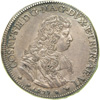 |
Italian States -- Tuscany. Piastre, 1677 (Florence). Dav-4209; CNI-XII, 36; Morosini-2. 31.16 grams. Cosimo III di Medici, 1670-1723. Draped and cuirassed bust right. Reverse: Christ baptized by a rimbate John, the hand of God above. Better, even strike. Fine old multi-hued gray toning over ample original luster. NGC graded AU-58.
Cosimo was one of the worst of the Medicis. Religiously intolerant, he imposed moral restrictions that angered the populace and reminded many of the earlier Savanarola. He presided over an extravagant court, raised taxes to support the extravagances, appointed himself Minister of Justice, and inflicted harsh punishments on the "unfaithful."
Estimated Value $4,000 - 5,000.
View details and enlarged photos
| Realized
$4,255 |
Lot 739 |
 |
Italian States -- Tuscany, Livorno. Tollero, 1704. Dav-1498; KM-16.5; CNI-75; Galeotti-45/5; Ravegnani-M. 15. 27.16 grams. Cosimo III di Medici, 1670-1723. Radiate-crowned and cuirassed bust right. Reverse: View of the harbor of Livorno, showing the fortress, harbor, and lighthouse in the foreground. Exceptional strike, with only minimal weakness to the hair. Choice, crisp details, and ample original luster. Lightly toned a sumptuous original silvery gray with hues of iridescence. NGC graded MS-63.
In 1421 the Republic of Florence bought the city of Livorno, establishing for itself a coastal outlet, and thus maritime access. The rise and the fortunes of the city soon become inextricably intertwined with those of the Medici family, long one of the most important families in Florence, and by extension Tuscany. The Medicis would eventually transform the Republic of Florence into a Ducal State ruled by their hereditary succession until the 18th century. In fact, developing the commercial potential of Livorno became a pet project of the Medicis. In 1571 Cosimo I started the construction of the Porto Mediceo. Planned as an "ideal town" for the 16th century, it was characterized by regular layout, with the districts overlaid with the Medicean canals, which are still navigable today. The port is overlooked by towers and fortresses, with easy road access to the town center. These images are portrayed here.
Estimated Value $3,000 - 3,500.
Illustrated in Money of The World, coin 113.
View details and enlarged photos
| Realized
$4,830 |
Lot 740 |
 |
Italian States -- Tuscany. Francescone, or silver 10 Paoli, 1772 (Florence). Dav-1514; KM-24.1; Mont.-43. 27.34 grams. Pietro Leopoldo di Lorena, 1765-1790. Youthful bust right, cuirassed, and draped with sash and orders. Reverse: Crowned rectangular arms within order chain, all before eight-rayed star. Superior strike, the obverse bold and complete. Obverse with satiny devices on mirror-like fields (showing some light marks and faint hairlines); reverse virtually pristine with lightly reflective fields. Handsome toning, russet to pink in the recesses. Very rare in this grade, with a marvelous portrait. NGC graded MS-63.
Estimated Value $6,000 - 7,000.
View details and enlarged photos
| Realized
$9,488 |
Lot 741 |
 |
Venice. Scudo d'oro, ND. Fr-1448; CNI VII pl.IX,16. 3.02 grams. 23.50 mm. Andrea Gritti, 1523-1539. Obv: Large cross. Leg: +ANDREAVS. GRITI.DVX.VENETIV& Reverse Lion in shield. Leg: +.SANCTVS. MARCVS.VENETVS. NGC graded AU-58.
Scudo d'oro types are far scarcer than the zecchinos. Note the mention of St. Mark, patron saint of Venice.
Estimated Value $1,200 - 1,400.
(*).
View details and enlarged photos
| Unsold |
Lot 742 |
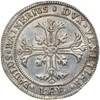 |
Italian States -- Venice. Scudo of 140 Soldi, ND - L.A.F. Dav-1564; C-93. 27.75 grams. Paolo Renier, Doge, 1779-1789. Floriated cross, with lis at angles. Reverse: Ornate shield with emblem of St Mark, a winged and nimbate lion, within. Lustrous, with reflective fields. Lightly toned. Rare this nice -- in fact, quite exceptional! NGC graded MS-64.
Venice became a major sea power in the Middle Ages, its main source of wealth being trade with the East and its main rival the Byzantine Empire. Ironically, as Venice conspired against the Byzantines, the Turks took over the region and closed off trade with the West. So Venice's success was also its undoing. Here is a fabulous representation of the wealth of its heyday.
Estimated Value $2,000 - 2,500.
View details and enlarged photos
| Realized
$2,070 |
Lot 743 |
 |
Italian States -- Venice. Silver Ducato, ND (1779). Dav-1567; Cr-100. Assayer, LAF. Paolo Renier, 1779-1789. Lion of St Mark. Reverse: Seated and kneeling figures with banner. Boldly struck and toned in shades of violet and silvery gray. Rare this nice. NGC graded MS-65.
Estimated Value $1,500 - 2,000.
View details and enlarged photos
| Realized
$4,140 |
Lot 744 |
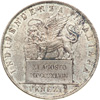 |
Italian States -- Venice. 5 Lire, 1848. Dav-208; Pagani-178; C-185. Revolutionary Issue. Lion of St Mark holding Gospels, standing left on a raised platform inscribed: XI AGOSTO, MDCCCXLVIII. Reverse: Value within oak wreath. Excellent strike, on lustrous, glossy fields. Speckled iridescent toning, with touches of green, red and blue. Some faint hairlines on reverse. Handsome example of this dignified design. NGC graded MS-63.
Struck during a year of revolution throughout Europe. France was at the barricades, Milan and Venice attempting to revolt from their Austrian overlords. None of the revolts succeeded but a few more years would end most of the autocratic regimes. This representational issue is the finest one we could find for inclusion in the Millenia Collection.
Estimated Value $800 - 1,000.
View details and enlarged photos
| Realized
$1,265 |
Lot 745 |
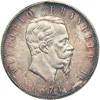 |
Italy. 5 Lire, 1874-M (Milan). Dav-140; KM-8.3 Victor Emmanuel II. Bearded portrait right. Reverse: Royal crest within wreath. An exceptional coin, choice with light golden lilac toning. NGC graded MS-63.
Estimated Value $225 - 275.
View details and enlarged photos
| Realized
$357 |
Lot 746 |
 |
Italy. 100 Lire, 1883-R (Rome). Fr-18; KM-22; Y-34. Umberto I. Mintage of only 4,219 pieces. Head left. Reverse: Crowned arms within wreath. Full mint brilliance. Rare. NGC graded MS-62 Prooflike.
Umberto was a conservative or reactionary king. He applauded the use of force to quell a popular people's uprising in Milan in 1898, which left hundreds dead. He embarked on a policy of colonial expansion in Africa while there were food shortages at home. He became hated by the general population and was also the only Italian king ever assassinated.
Estimated Value $4,000 - 5,000.
View details and enlarged photos
| Realized
$8,050 |
Lot 747 |
 |
Italy. 20 Lire, 1926-R. Fr-28; KM-48; Pagani-668 (Rarity-4). Vittorio Emanuele III, 1900-1946. Uniformed bust left. Reverse Agricultural scene. Mintage of only 40 pieces struck. Excessively rare date. NGC graded MS-65.
Estimated Value $15,000 - 20,000.
(*).
View details and enlarged photos
| Realized
$23,000 |
Lot 748 |
 |
Italy. 20 Lire, 1927-R. Fr-28; KM-48; Pagani-669 (Rarity-4). Vittorio Emanuele III, 1900-1946. Uniformed bust left. Reverse Agricultural scene. Mintage of only 30 pieces struck. Excessively rare date. NGC graded MS-66.
Estimated Value $15,000 - 20,000.
(*).
View details and enlarged photos
| Realized
$25,300 |
Lot 749 |
 |
Italy. 20 Lire, 1933 (A.XI). Dav-145; KM-69; Pagani-678 (Rarity-3). Vittorio Emmanuel III, 1900-1946. Head right. Reverse ITALIA, standing and seated figures, dates at left and right, value below. Mintage of only 50 pieces struck. Extremely Rare date. NGC graded MS-65.
Estimated Value $5,000 - 7,000.
(*).
View details and enlarged photos
| Realized
$8,625 |
Lot 750 |
 |
Italy -- Achaia. Frankish Possessions in Greece. Imitation Venetian Ducat, ND. 3.54 grams. In the name of Andrea Dandolo, 1343-1354. Saint Mark at left, presenting banner to kneeling Doge at right; blundered inscription. Reverse: Christ facing, within mandorla with nine stars, small gothic "c" to left of Christ's feet; blundered inscription. A. Savio, "Imitazione e contraffazione del ducato d'oro di Venezia," QT VI, pp. 399-400; Tzamali pp. 73-74; cf. Castellani 16224; cf. Gamberini 344 (to Robert d' Anjou); cf. Ives p. 24, no. 45 and pl. XII, 1; cf. Fr-38a (Italy, Achaea: to Robert d' Anjou, Duke of Achaea). Sharply struck imitation in good Venetian style, and high-karat gold. Perfectly centered, without the usual traces of die rust. A superior example of this imitative trade coinage. NGC graded MS-65.
The great quantities of these ducats that have been recovered indicate that they served as the principal trade currency of the Crusader east for several decades in the second half of the 14th century. The site and hoard finds suggest a manufacturing source in the eastern Mediterranean -- perhaps at Chios, then under Genoese rule, or Mytilene, under the Gattilusi.
Estimated Value $1,000 - 1,250.
Illustrated in Money of The World, coin 73.
View details and enlarged photos
| Realized
$2,760 |
|
|